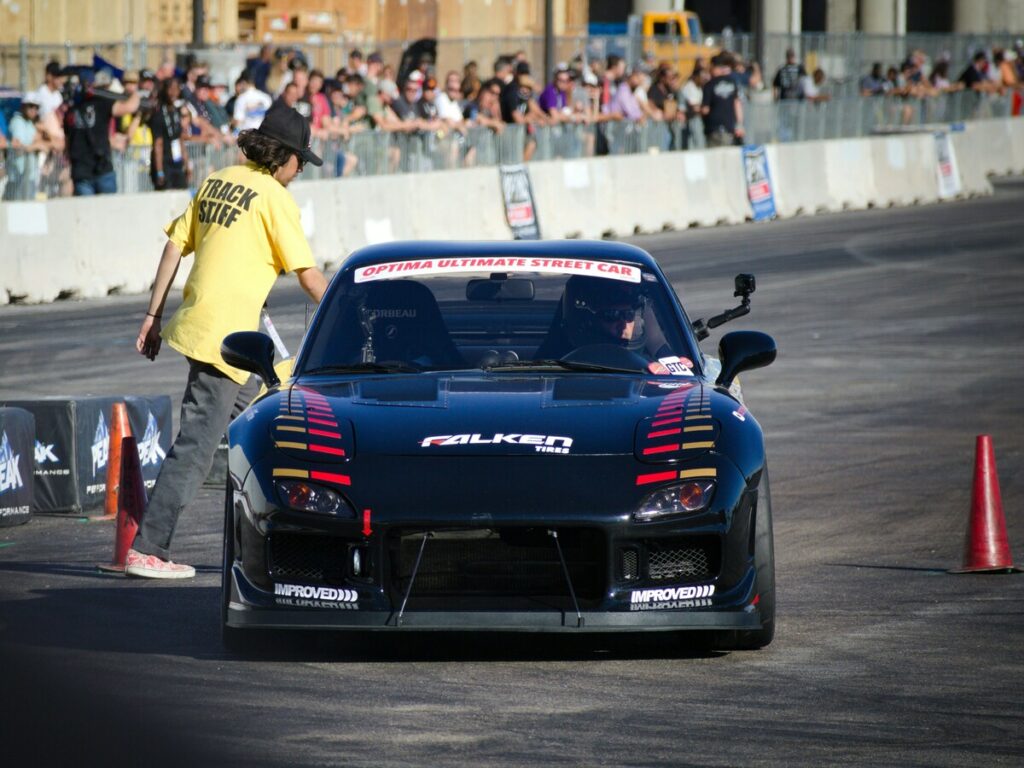El papel de los conos de tráfico en el autocross: Navegando con precisión y habilidad

When you think of autocross, the first thing that comes to mind might be speed and skill. But have you ever considered how much of that excitement depends on orange cones? These bright orange markers, often called pylons, are more than just obstacles. They shape the course, guide your path, and push your driving precision to its limits. Autocross cones create a dynamic environment where every turn, slalom, and gate tests your control and reflexes. sin ellos, the sport wouldn’t challenge you in the same way or offer the same thrill.
Understanding Autocross: A Sport of Precision and Skill
What Is Autocross?
Autocross is a motorsport that combines speed, precision, and skill. Unlike traditional racing, it takes place on a temporary course marked by traffic cones, often set up in large parking lots or open spaces. The goal is simple: navigate the course as quickly as possible without hitting any cones or going off track. Each run is timed, and the driver with the fastest clean run wins.
What makes autocross unique is its accessibility. You don’t need a high-performance race car to participate. Many drivers use their daily vehicles, making it an excellent entry point into motorsports. It’s also one of the safest ways to test your driving abilities. The controlled environment ensures you can push your limits without the risks associated with high-speed racing.
Autocross has come a long way since its beginnings in the 1950s. Back then, courses were often set up on grassy fields, offering a basic challenge for drivers. Hoy, the sport has evolved into a professional discipline recognized by organizations like the Sports Car Club of America (SCCA) y National Auto Sport Association (NASA). Modern courses feature sealed and unsealed surfaces, giros agudos, and even jumps, providing a thrilling experience for participants.
Why Precision and Skill Are Central to Autocross
In autocross, precision isn’t just important—it’s everything. The course layout, defined by cones, demands accurate steering and throttle control. A single mistake, like hitting a traffic cone or missing a gate, can cost you valuable seconds or even disqualify your run. This focus on precision makes autocross a true test of your driving skills.
Skill plays an equally vital role. Autocross challenges you to master techniques like quick cornering, smooth acceleration, and controlled braking. The tight turns and slaloms require you to think ahead and adapt quickly. Every decision you make behind the wheel impacts your performance.
The sport’s emphasis on precision and skill also fosters growth. Each run teaches you something new, whether it’s how to approach a tricky section or how to balance speed with control. Con el tiempo, you’ll notice improvements not just in your autocross performance but also in your everyday driving. That’s the beauty of this sport—it sharpens your abilities while keeping the experience fun and rewarding.
“Autocross is the art of driving at the limit, but with precision and control.” This quote perfectly captures the essence of the sport. It’s not just about going fast; it’s about doing so with finesse.
Whether you’re a beginner or a seasoned driver, autocross offers endless opportunities to refine your skills. The combination of precision, skill, and the thrill of competition makes it a motorsport like no other.
Autocross Cones: The Building Blocks of the Course

How Cones Define the Course Layout
When you step onto an autocross course, the first thing you notice is the sea of traffic cones. These traffic cones aren’t just scattered randomly; they’re carefully placed to create a unique and challenging layout. They define every twist, turn, and straightaway, guiding you through the course like a map brought to life. sin ellos, there wouldn’t be a course to navigate.
Each orange cone serves a purpose. Some mark gates you must pass through, while others outline slaloms that test your rhythm and timing. Tight turns and sweeping curves come to life because of how orange cones are arranged. Their placement determines the flow of the course, ensuring it’s both exciting and safe. Unlike permanent tracks, autocross courses rely entirely on these portable markers, making every event feel fresh and unpredictable.
The beauty of this setup lies in its simplicity. Autocross cones allow organizers to design courses in open spaces like parking lots or airfields. This flexibility keeps the sport accessible and affordable for everyone. You don’t need a professional racetrack to experience the thrill of autocross. Instead, cones transform everyday spaces into arenas of precision and skill.
OPTsigns orange traffic cones with their superior design and high manufacturing standards, have become the preferred choice for many event organizers and venue managers. Estos orange cones‘ bright color offers high visibility in various environments, ensuring clear boundary and obstacle markings in both daylight and low-light conditions, thus guaranteeing safety for drivers.
“Autocross cones are the architects of autocross,” shaping the path and defining the challenges you’ll face.
The Flexibility and Creativity of Cone-Based Course Design
One of the most exciting aspects of autocross is how safety cones enable endless creativity in course design. No two events are ever the same because organizers can rearrange the autocross cones to create entirely new layouts. This flexibility keeps the sport dynamic and engaging, whether you’re a first-timer or a seasoned driver.
Organizers use autocross cones to craft courses that test a wide range of driving skills. You might encounter tight hairpins that demand sharp steering or long slaloms that challenge your timing. Offset gates and chicanes push you to adapt quickly, keeping you on your toes. The possibilities are limitless, and each design brings its own set of thrills.
Cone-based courses also prioritize safety. Since the layout is temporary, designers can adjust it to suit the venue and ensure maximum safety for drivers and spectators. Speeds typically stay below 60 MPH, making autocross a controlled environment where you can push your limits without unnecessary risks.
This adaptability makes autocross one of the most inclusive motorsports. Whether you drive a sports car or a daily commuter, the course will challenge you in ways that improve your skills and boost your confidence. The autocross cones don’t just build the course; they build your abilities as a driver.
The Role of Autocross Cones in Testing Driver Skills
Creating Challenges with Cones
Autocross cones are more than just markers; they are the ultimate test of your driving abilities. Each cone on the course serves a purpose, whether it’s to guide you through a slalom, mark a tight turn, or define a tricky gate. These challenges force you to stay sharp and adapt quickly. You can’t just rely on speed; you need precision and control to navigate the course effectively.
The placement of driveway cones creates a variety of obstacles that test different aspects of your skills. A slalom, for example, demands rhythm and timing as you weave through the driveway cones. Tight hairpins push your steering precision to the limit, while offset gates challenge your ability to adjust your line on the fly. Every section of the course is designed to keep you engaged and focused.
It is important to highlight that portability is another key feature of Conos de tráfico de Optsigns. Designed with ease of transport and storage in mind, these traffic cones can be stacked easily for convenient storage and transportation. Whether used in large parking lots or open fields, users can quickly set up or rearrange these traffic cones, providing flexible solutions for various venue requirements.
“Learning to read an autocross course is your first priority when you are new to autocross,” says a novice coordinator. During the course walk-through, you’ll start to understand what each cone represents and how to approach it. This knowledge becomes your foundation for tackling the challenges ahead.
The beauty of these cone-based challenges lies in their unpredictability. No two courses are ever the same, so you’re constantly learning and improving. Each event brings new layouts that push you to refine your techniques and think strategically. The cones don’t just test your skills—they help you grow as a driver.
The Penalty System: What Happens When a Cone Is Hit or Missed?
In autocross, precision isn’t just encouraged—it’s required. The penalty system ensures that every driveway cone matters. If you hit a driveway cone or miss a gate, you’ll face time penalties that can make or break your run. This system adds an extra layer of pressure, pushing you to stay focused and execute each maneuver flawlessly.
Here’s how it works:
- Hitting a cone: If you knock over or displace a cone, a time penalty (usually two seconds) gets added to your run. This might not seem like much, but in a sport where fractions of a second matter, it can cost you the win.
- Missing a gate: Failing to pass through a designated gate results in a more severe penalty or even disqualification. This emphasizes the importance of reading the course and staying on the correct path.
The penalty system rewards clean, precise driving. It’s not enough to be fast; you need to be accurate. This balance between speed and control is what makes autocross so unique and challenging. Every decision you make on the course carries weight, from how you approach a slalom to how tightly you take a corner.
Mistakes are inevitable, especially when you’re starting out. But each penalty is an opportunity to learn. Con el tiempo, you’ll develop a better understanding of the course and how to navigate it without errors. The satisfaction of completing a clean run, free of penalties, is one of the most rewarding aspects of the sport.
Maneuvers Made Possible by Autocross Cones
Slaloms: Testing Rhythm and Timing
Slaloms are one of the most iconic features of an autocross course. They consist of a series of cones placed in a straight or staggered line, requiring you to weave through them with precision. Success in slaloms depends on rhythm and timing. You need to anticipate each cone’s position and adjust your steering and throttle accordingly. The key is to maintain a smooth flow without overcorrecting or losing speed.
When approaching a slalom, focus on looking ahead. Visualize the path you need to take before you even reach the first cone. This technique helps you stay in control and avoid abrupt movements. As you navigate the slalom, aim for consistency. Each turn should feel like part of a seamless dance between you and the car.
“Looking ahead and visualizing the line is crucial for successful autocrossing,” as experienced drivers often say. This advice applies perfectly to slaloms, where foresight can make all the difference.
Slaloms test your ability to balance speed and control. Push too hard, and you risk hitting a cone or losing your rhythm. Go too slow, and you’ll sacrifice valuable time. Mastering this maneuver will not only improve your autocross performance but also enhance your overall driving skills.
Hairpins and Tight Turns: Steering Precision
Hairpins and tight turns are where autocross cones truly challenge your steering precision. These sharp, often 180-degree turns demand quick reflexes and accurate control of your vehicle. To tackle them effectively, you need to use the entire width of the course. This approach allows you to carry more speed into and out of the turn.
When entering a hairpin, brake early and position your car for a smooth exit. Keep your eyes on the next cone or gate to plan your line. The goal is to minimize the distance traveled while maintaining enough momentum to accelerate out of the turn. Tight turns require similar techniques but often come with less room for error. Every movement of the steering wheel matters.
Understanding the physics behind these maneuvers can give you an edge. Por ejemplo, the speed you carry near the apex of a hairpin directly impacts your exit. Slowing down slightly before the turn can help you maintain better control and avoid penalties.
“Using the entire track width and managing speed near cone 2 can significantly improve performance,” according to autocross experts. Applying this principle to hairpins can shave seconds off your time.
Hairpins and tight turns highlight the importance of precision. They force you to think strategically and execute each move with care. Con el tiempo, these challenges will sharpen your skills and boost your confidence behind the wheel.
Chicanes and Offset Gates: Adapting to Complex Layouts
Autocross courses are made more complex by the addition of chicanes and offset gates. A chicane consists of a series of quick left-right or right-left turns, designed to slow you down and test your adaptability. Offset gates, por otro lado, require you to adjust your line as you pass through staggered cones. Both obstacles demand quick thinking and precise execution.
To navigate a chicane, focus on maintaining a steady rhythm. Avoid abrupt inputs that could unsettle your car. Instead, aim for smooth transitions between turns. The key is to find the right balance between speed and control. Too much speed can cause you to overshoot, while excessive caution can cost you time.
Offset gates challenge your ability to read the course and plan your moves. During the course walk-through, pay close attention to the spacing and angles of the driveway cones. This preparation will help you anticipate the adjustments needed during your run. As you approach each gate, keep your movements fluid and deliberate.
“Transitioning between driveway cones and maximizing control are crucial for successful autocross driving,” as highlighted in training guides. These skills are especially important when tackling chicanes and offset gates.
Chicanes and offset gates push you to adapt quickly and think on your feet. They test your ability to stay composed under pressure and make split-second decisions. Conquering these challenges will make you a more versatile and confident driver.
Mastering the Art of Navigating Autocross Cones

Precision Driving: Steering and Throttle Control
Mastering precision driving in autocross starts with understanding how to control your steering and throttle. Every movement you make behind the wheel directly impacts your performance. Smooth and deliberate inputs are key. Jerky or rushed actions can unsettle your car, making it harder to stay on course.
When steering, focus on being precise rather than aggressive. Small, controlled adjustments help you maintain the ideal line through turns. Oversteering or understeering can cost you valuable time and even lead to penalties if you hit a cone. Your goal is to guide the car with confidence, keeping it balanced as you navigate each section.
Throttle control is equally important. Too much gas can cause wheel spin, while too little can slow you down unnecessarily. The trick is to modulate the throttle based on the course layout. Por ejemplo, in tight sections, ease off the gas to maintain control. In straights or acceleration zones, apply power smoothly to maximize speed without losing traction.
“Always look for ways to make acceleration zones that carry the most speed,” advise instructors at Cone College. This means planning your throttle use strategically to gain an edge.
By combining precise steering with thoughtful throttle control, you’ll find yourself navigating the course more efficiently. These skills not only improve your autocross runs but also enhance your overall performance driving abilities.
Reading the Course: Anticipating Cone Layouts
Before you even start your run, you need to understand the course. Autocross courses are temporary and unique to each event, so memorizing the layout is crucial. During the course walk-through, take your time to study the cone placements. Look for gates, slaloms, and tight turns that will require extra attention.
Experienced drivers often say, “Look as far ahead as possible.” This advice is invaluable. By keeping your eyes up and scanning the course, you can anticipate upcoming challenges and plan your moves. Por ejemplo, if you see a slalom ahead, start positioning your car early to set yourself up for a smooth entry.
Not every cone on the course matters equally. According to instructors, “Most courses can be defined by maybe 20 conos; the other hundred or so are noise that needs to be tuned out.” Focus on the critical cones that define the path. Ignoring unnecessary distractions helps you stay sharp and avoid mistakes.
Memorizing the course and anticipating cone layouts give you a significant advantage. You’ll feel more confident and prepared, which translates to better performance on the track.
Balancing Speed and Control: Achieving the Best Time
In autocross, speed alone won’t win you the race. You need to balance speed with control to achieve the best time. Pushing too hard can lead to mistakes, like hitting cones or missing gates. Por otro lado, being overly cautious can slow you down and hurt your chances of success.
The fastest line through the course isn’t always the one closest to the cones. A veces, taking a wider approach allows you to carry more speed through a turn. Experiment with different lines during practice runs to find what works best for you. Remember, the goal is to minimize the time spent navigating each section.
Acceleration zones are another area where you can gain or lose time. Plan your exits from turns to maximize speed in these zones. Smooth transitions between braking and acceleration help you maintain momentum without unsettling the car.
“The fastest line is not always the one closest to the cones,” say experts. Keeping this in mind can help you make smarter decisions on the course.
Balancing speed and control requires practice and patience. Con el tiempo, you’ll develop a feel for how to push your limits without overstepping them. This balance is what makes autocross such a rewarding challenge.
Challenges and Growth Through Autocross Cones
Common Mistakes and How to Avoid Them
When you’re navigating an autocross course, mistakes are bound to happen. The key is recognizing them and learning how to avoid them in the future. One of the most common errors is focusing too much on individual cones instead of the overall path. If you fixate on each cone, you’ll struggle to maintain a smooth line through the course. Instead, look ahead and visualize the path your car needs to take. This approach helps you stay fluid and reduces abrupt corrections.
Another frequent mistake involves overdriving the car. Many drivers push too hard, causing them to lose control or hit cones. Remember, speed isn’t everything in autocross. Precision and control matter just as much. Practice balancing throttle and steering inputs to keep your car stable and on course. Por ejemplo, in tight turns, easing off the throttle can help you maintain better control without relying solely on the steering wheel.
Lastly, skipping the course walk-through is a big misstep. Without understanding the layout, you’ll waste valuable time figuring it out during your run. Use the walk-through to identify tricky sections and plan your strategy. Pay attention to gates, slaloms, and offset cones that might require extra focus. Preparation is your best tool for avoiding costly errors.
“Mistakes are part of the learning process. Each one teaches you something new about the course and your driving.”
How Cones Help Drivers Improve Skills
Autocross cones are more than just obstacles; they’re tools for growth. They force you to refine your precision and adaptability. Por ejemplo, navigating a slalom requires you to focus on the space between cones rather than the cones themselves. By visualizing the line your car will take, you’ll develop a smoother and more efficient driving style.
Cones also teach you how to make small adjustments with the throttle instead of relying solely on the steering wheel. In steady turns, slight changes in throttle input can help you position your car more effectively. This skill not only improves your autocross performance but also enhances your everyday driving.
The constant variety of cone layouts keeps you on your toes. Each course presents new challenges, pushing you to adapt quickly. Con el tiempo, you’ll notice significant improvements in your ability to read a course and anticipate its demands. These skills translate into better control, sharper reflexes, and greater confidence behind the wheel.
“Cones are your teachers on the track. They guide you, challenge you, and ultimately make you a better driver.”
The Psychological Aspect: Staying Focused and Learning from Errors
Autocross isn’t just a physical challenge; it’s a mental one too. Staying focused throughout your run is crucial. Distractions or second-guessing yourself can lead to mistakes. To maintain focus, keep your mind on the task at hand. Don’t dwell on a cone you might have clipped earlier in the run. Instead, reset your attention on the next section of the course.
Learning from errors is another vital part of the psychological game. Every missed gate or penalty is an opportunity to improve. After each run, take a moment to reflect. What went well? What could you have done differently? Use this feedback to adjust your approach for the next attempt.
Confidence plays a huge role in your performance. Trust your instincts and the preparation you’ve done during the course walk-through. Visualize a successful run before you even start. This mental rehearsal can help you stay calm and execute your plan with precision.
“Autocross challenges your mind as much as your driving skills. Staying focused and learning from mistakes are the keys to growth.”
The Autocross Experience: Why Cones Matter
The Unique Challenges Cones Bring to Autocross
When you step onto an autocross course, the orange cones immediately grab your attention. They’re not just there to mark the path; they’re there to test you. Each road cone placement creates a unique challenge, forcing you to adapt and think on your feet. You’ll find yourself weaving through slaloms, navigating tight hairpins, and adjusting to offset gates. Every section of the course demands precision, quick reflexes, and a deep connection with your car.
The beauty of these challenges lies in their unpredictability. No two courses are ever the same. One day, you might face a layout that emphasizes sharp turns and technical maneuvers. The next, you could be speeding through long straights and wide arcs. This constant variety keeps you engaged and ensures that every run feels fresh and exciting.
“The pedal dance unlocks magic with this car,” shared one experienced autocross driver. “It’s so fun feeling the rear slide out and bringing it back under control with the throttle.”
This quote perfectly captures the thrill of mastering cone navigation. The cones push you to explore the limits of your car and your skills. They challenge you to stay focused, make split-second decisions, and execute each maneuver with precision. The satisfaction of conquering these obstacles is unmatched.
The Joy and Satisfaction of Mastering Cone Navigation
There’s something incredibly rewarding about nailing a clean run on an autocross course. Each cone you pass without penalty feels like a small victory. By the time you cross the finish line, you’re left with a sense of accomplishment that’s hard to describe. It’s not just about speed—it’s about control, strategy, and execution.
As you grow more comfortable with the challenges, you’ll start to notice the joy in the process itself. The rhythm of weaving through a slalom, the precision of hitting the perfect apex, and the thrill of accelerating out of a tight turn all come together to create an unforgettable experience. You’re not just driving; you’re dancing with the car, and the cones are your partners.
“I really enjoyed it,” said a seasoned driver. “With each run, I felt more comfortable, even though the tight little autocross course was just a teaser for what a real track day would be like.”
This sense of progression is what makes autocross so addictive. Each run teaches you something new, whether it’s a better way to approach a tricky section or how to balance speed and control more effectively. Con el tiempo, you’ll find yourself looking forward to the next challenge, eager to see how much you’ve improved.
The joy of mastering cone navigation goes beyond the track. It’s a reminder that growth comes from pushing your limits and embracing challenges. Whether you’re a beginner or a seasoned pro, the cones will always have something to teach you. And that’s what makes them so special.
Traffic cones are the unsung heroes of autocross. They don’t just mark the course; they define the entire experience. Each cone challenges you to refine your precision, control, y adaptabilidad. Whether you’re weaving through a slalom or navigating a tight hairpin, these cones push your skills to new heights. They transform open spaces into thrilling arenas where every second counts.
Autocross events offer more than competition—they provide growth. The joy of completing a clean run, free of penalties, highlights the excitement of this accessible motorsport. With every cone you conquer, you become a better driver.



















